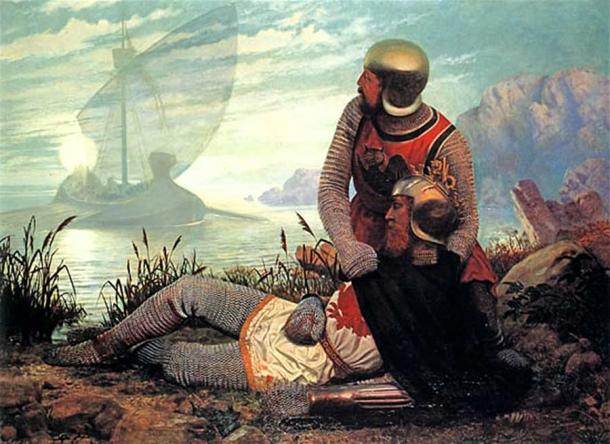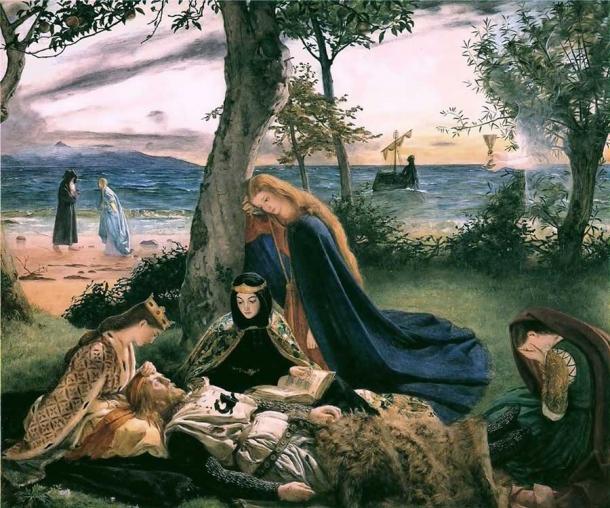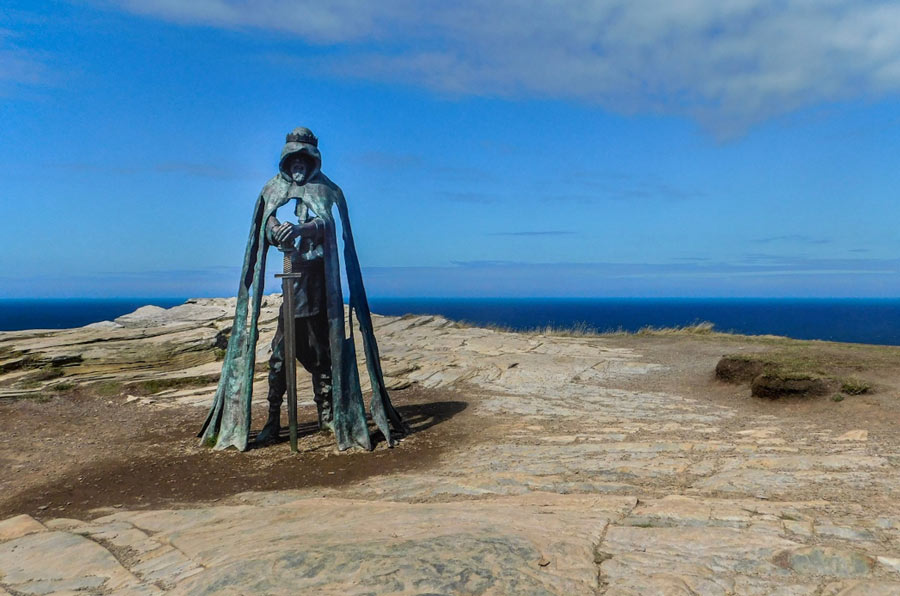The Royal Burials of 65 Celtic Kings Identified in England and Wales
Researchers in England had always known there was something special about these 65 graves. Now, a new paper explains that these are likely the resting places of powerful post-Roman period Celtic kings.
England’s Tara Rivaling Royal Burials of Celtic Kings
Everyone has heard of the sacred Hill of Tara in Ireland’s Boyne Valley. This deeply-ancient landscape is known as the “jewel in the crown” among the mystical island’s hundreds of archaeological sites. While this is perhaps an overused term in tourism, Tara really did see a lot of crowns as it was the inauguration and assembly site for ancient High Kings who used the hill as a burial place for more than 5,000 years.
- The Hill of Tara: Tracing the Footsteps of the High Kings of Ireland
- Touching 4,000-Year-Old Royal Double Burial Found in Kazakhstan
Now, an archaeologist in England has identified “20 probable royal burial complexes.” It is believed each burial contains up to five graves, and there are possibly another 11 burial complexes as well. Dating to the 5th and 6th centuries AD, it is suspected that up to “65 buried British Kings and senior royals from the Dark Age” are buried at these Tara-rivaling sites.

Tintagel Castle in Cornwall, where some of the newly identified graves of Celtic kings were discovered. (valeryegorov / Adobe Stock)
Bigger Countries Had More Regional Kings
The new study has been published by the Royal Society of Antiquaries of Ireland. Professor Ken Dark of the University of Reading and Spain’s University of Navarra led the research in Wales, Cornwall, Devon and Somerset that led to the identification of the “indigenous high-status royal burials.”
While the kings of Tara were rulers over rich agricultural lands on the western island, across the Irish Sea, these newly identified graves hold the corpses of British kingdom rulers who governed over regions of Wales and southern England. Among the most important of these royal burials were found in North Wales at Caernarfon and Anglesey and in England’s Cornwall at Tintagel Castle, which legends associate with the mythical King Arthur.

The Death of King Arthur by John Garrick. (Public domain)
Grand Royal Graves with Entry Gates
Soon after the collapse of the Roman Empire in the 5th century the invaders abandoned their outpost of Britannia. As a result, in the east and south of England many smaller kingdoms were formed and ruled by Anglo-Saxon kings. Dr. Dark wrote that these people were “of fully or partially Germanic origin.” At the same time in the west and north of England, post-Roman Celtic royal dynasties began emerging from indigenous British and Irish dynastic family lines.
While nine Anglo-Saxon royal graves had been found on previous excavations, before this new study, according to The Independent, “only one post-Roman burial of an indigenous British monarch from the Dark Ages had been identified.” These nine excavated sites were compared with the formats of royal burials in Ireland. The archaeologists noted that the British royal burial sites “have rectangular or square ditched enclosures.” Furthermore, most of these burials had entry gates and access causeways protected by fences or palisades, explained Ken Dark.
Bringing Light to the British Dark Age
Ken Dark said these 65 burials were found by archaeologists across England over several decades. However, only now, and as a result of the new study, are they being accepted as royal graves. The professor added that while the graves have now been identified as royal, discovering the actual names of the individual kings becomes the focus of his ongoing work.
Post-Roman Britain experienced a great spread of Angles, Saxons, and Franks who all had their powerful regional rulers. While it is known that a kingly duo called Horsa and Hengist ruled much of southern England, there was also Cerdic, a major Saxon king who can be traced to all royalty in Britain today.
- Historians Draw Closer to the Tomb of the Legendary King Arthur
- High Status Anglo-Saxon Burials in Suffolk, England, Linked to Ancient King of East Anglia

Study claims that the burials of as many as 65 post-Roman Celtic kings have been found in England and Wales. The death of King Arthur by James Archer. (Public domain)
Now, if Dark has anything to do with it, British historians might soon have a stack of new king’s names to add to their books. When speaking with The Independent, he explained that prior to his new study British archaeologists were “completely unaware of the large number of probable royal graves surviving from post-Roman western Britain.” The researcher is convinced that his ongoing investigations will ultimately change our understanding of important aspects of what he calls “a crucial period of British history.”
Top image: King Arthur statue at Tintagel Castle, one of the mysterious Celtic Kings of legend. Source: Alex / Adobe Stock
By Ashley Cowie




















Comments
The current castle at Tintagel is 13th century, Earl Richard of Cornwall building it on this site as the site was known to be connected with the kings of the past. Durocornouio, recorded in 400 AD in the Roman Ravenna Cosmography, has been identified as Tintagel and translates as “fortress of the Cornovii or Cornish". Some of the kings who would have been associated with the citadel of Tintagel would have been, starting from the earliest: Guyvor, Tudwal, Cynvor, who may be the Cunomorus named on Fowey’s Tristan Stone (Cunomorus is a Latinised form of the Celtic name Cynvor). He could also be the man mentioned in the 9th century Breton monk Wrmonoc’s Life of St Paul Aurelian as the king Quonomorius, also called Marcus, and therefore he may also be the famous King Mark of Cornwall.
The next king, Constantine, was king when the monk Gildas wrote around 540 AD. He castigated five contemporary British (Celtic) kings and called Constantine: “the tyrannical whelp of the unclean lioness of Dumnonia”. Welsh records refer to him as Custennin Gorneu (“of Cornwall”).
He was succeeded by Erbin, another name which crops up in Welsh tradition as does the name of the next king, Gerent I. He might have been the Gerent rac Deheu (“Gerent for the south”) who fought against the English at Catraeth (Catterick, Yorkshire) in 598. The next king was Cado, remembered by Geoffrey of Monmouth as Cador of Cornwall. After him come Peredur and Theudu.
The king list fizzles out at this point but we know of Gerent II, possibly Theudu’s successor. In 705, the Synod of Wessex wrote to “Gerontius Rex”, demanding that the Celtic (Columban) Church in Cornwall conform to the doctrines of Rome.
After Gerent II is a gap of 170 years before records of another Cornish king, Donyarth, recorded by the Annales Cambriae as having drowned in 878 AD. The Annales refer to him as “rex Cerniu” (“king of Cornwall”). Fifty years later, we find another one, Huwal, called by the Anglo-Saxon Chronicles “king of the West Welsh”, a term exclusively used to describe the British Celts of Dumnonia and Cornwall (this was not Hywel Dda of South Wales). He was one of several kings who signed a treaty with Aethelstan of Wessex in 928 at Egmont Bridge
One would imagine these kings could have been buried near Tintagel.
Did someone say bad records? English Heritage knows all the above yet refuses to acknowledge it. EH can’t be accused of failing to live up to its name.
In Anglia et Cornubia.